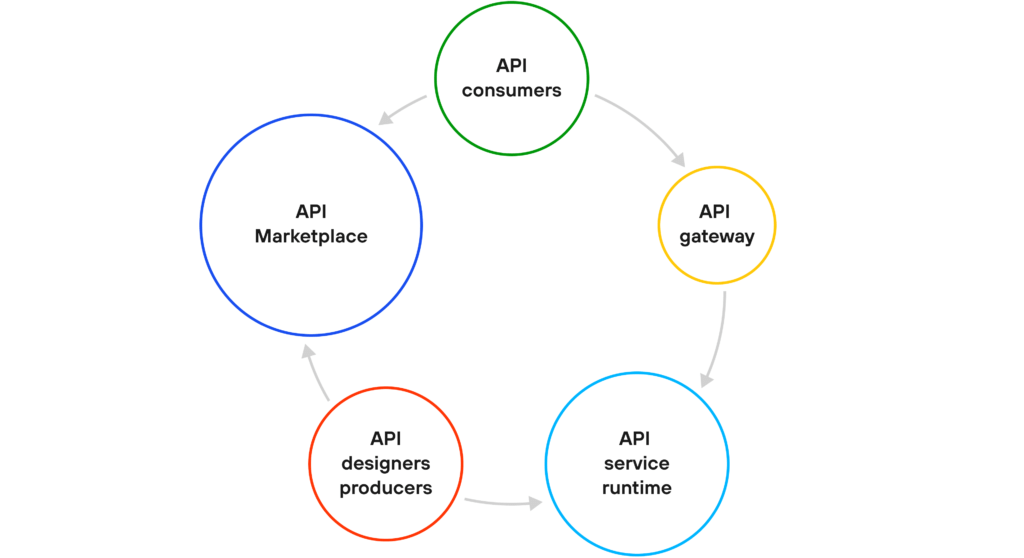API ecosystem as a backbone of modern digital enterprise
APIs for the business
Application Programming Interfaces (APIs) are decades old concepts, which were amplified by SOA architectures 20 years ago and then became a world wide industry standard with REST APIs for … almost everything.
The very term APIs wasn’t known outside the development community, but now we can talk about entire economies based on APIs. So it definitely crossed the technological bubble boundaries and it has become almost synonymous with what business can offer to partners via B2B channels and to end customers with B2C channels.
Maybe “there’s no app for that”, but it’s likely now that “there’s an API for that”.
→Read more There’s (no) app for that: what it means for the enterprise and future of the term
API in modern digitized enterprise is a product. A product which earns money, and needs to be marketed and developed efficiently.
The “it’s just for developers” misconception
APIs are not for developers, well not in the first place for developers. This is the most common misconception, that APIs deliver something that developers want and just let them find good API providers and use their APIs efficiently. Isn’t it just their job in their technological world? Should the business even care?
Definitely yes.
APIs represent business functions that are a small but important part of business processes on which modern digital enterprises are based.
And those business functions, well you guessed it, work for business and have a direct impact on sales, product and service delivery, and cost efficiency.
Developer Experience matters
Yes, the developers are both producers and consumers of APIs. So what matters with APIs is the great Developer Experience (DX), otherwise developers will go elsewhere and despite the pressure they will follow the path which is most convenient for them and makes their work most efficient.
One of the first and greatest ideas for APIs was to create developer portals to help developers discover APIs, learn how to use them, create sandbox environments to play with them in, and prepare for them ready to use code samples that they can paste into their app codes.
And, developer portals are not going anywhere. Their importance is only growing.
Low code changes everything
With the meteoric rise in popularity of low code platforms and citizen developers, the importance of API marketplaces will grow accordingly.
→ There is more about Low code and citizen developers: Pros are invited
Low code platforms are the perfect fit for building interaction flows using existing APIs; it’s in their DNA. A properly implemented API marketplace is a great accelerator for the adoption of low code and Robotic Programming Applications (RPA).
This makes another argument against the “just for developers” misconception.
API marketplaces
The need for API marketplaces
According to the research and confessions of many enterprise developers, they lose a lot of time trying to find the right APIs, in which they can trust and rely on. Numbers? During my small research, I found that up to 80% of the invested time is wasted on this discovery part.
Entire IT departments would like to see, all in one place, what their API’s system can provide to internal API consumers and outside API clients.
APIs need to be promoted, described properly, and managed properly.
There are different types of API marketplaces with their pros and cons. For the sake of simplicity, I’m going to divide them into public and private.
Public
All cloud vendors publish their APIs for their subscribers and encourage them to use them in their business applications, such as in the SaaS or PaaS model. You can do almost anything through the APIs that their clouds provide.
APIs are necessary in the everything as code mega trend, which dominates the entire IT landscape.
→ Read more about Star as code – Everything as code, the times of total automation
Plus, there are marketplaces for Microsoft Office 365 with various components to buy.
We are really proud of our contributions to the Salesforce store with our unique components.
→ Have a look at “Trigger Control”, a New App by Avenga to Empower the Salesforce platform
There are public API marketplaces from various smaller and lesser known vendors which offer many services through their REST interfaces.
So why build from scratch if there are so many APIs available? Well, we wished it was that simple.
Why not public?
The trust issue is the number one reason, for starters. What happens with our data, who is really behind this API, and do they really follow all the necessary regulations (i.e., GDPR, privacy, sector specific)?
In many cases, it’s just a simple “no way of knowing”, from an IT compliance standpoint within the current state of regulations, as we know too well from our experience with pharmaceutical companies and financial institutions.
The BFSI (Banking, financial services and insurance) sector with their rich startup ecosystems seems to be more open for public APIs to be used for KYC, payments, etc. And, the startups are already prepared to prove their trustworthiness and comply with the regulations, certifying their API based products.
Still, other issues remain. By using 3rd party APIs we create dependencies on multiple organizations, whose fate may be unknown (especially during turbulent times). Their dedication to support a given API for years is another difficult question and may become a source of doubt.
And as always, we may not like the shape of the API contracts and security profiles, and in most of the cases our influence is very limited. We may be considered just another consumer, condemned to the “one size fits all” approach.
When we use the example of a weather API, which will provide the temperature in our city tomorrow, it’s hard to see, but once you try to build something more specific, you will the difficulties.
Sometimes it will be an acceptable trade off, compared to internal development, yet sometimes it will be another set of arguments against public APIs and their respective marketplaces.
Enterprise marketplaces
Enterprise API marketplaces are the answer for all the doubts and issues with data protection anchored to public APIs and the ability to control and modify APIs, as well as unified enterprise access control and monitoring.
Of course, you can still publish your APIs for your external partners and customers. The enterprise API marketplace is meant both for internal and external APIs.
The benefit of control is great, but it comes at the price of adopting existing API marketplace products and fitting them into the API ecosystem of the organization.
It’s a great help for achieving an evolutionary architecture for the enterprise that dynamically responds to the business context changes and new technological opportunities.
→ Avenga explains what is Evolutionary architectures in practice
Let’s have a look at the anatomy of the enterprise marketplace to understand better what they offer.
Elements of the API marketplace
Catalog of APIs
API catalog management is the key aspect of the marketplace. The ability to add and/or remove version APIs is fundamental.
The benefits are the discoverability of APIs, shortening the time to find APIs, and the reuse of existing APIs instead of creating new ones.
The APIs are usually divided into different business domains (products, services, customers, sales, support, etc.) and technological characteristics (streaming APIs, sync APIs, async APIs, system APIs, etc.).
Examples for developers
Code samples in multiple languages are the best and easiest way to make developers happy, so they are able to quickly use APIs in the different languages and frameworks.
Still, proper documentation about arguments, expected values, and error handling are indispensable in avoiding API consumer frustration. The time “saved” by not writing proper communications about errors will return in thousands of percents later during painful debugging sessions.
Social features
APIs as products need advertising and to build the mindshare of the developers, which are in this case internal customers. They have to know what products are available, how to use them, and how good they work. Social features like blogs, discussion groups, and webinars are of great help in achieving that.
Tech evangelists encourage developers to publish their APIs in the enterprise marketplace to enable other parts of the organization to benefit from their APIs.
Internal hackathons and gamification can further promote and encourage developers to use APIs from the marketplace and to publish new ones.
Standards encouragement and visibility
The API marketplace is a practical implementation of standards for documentation, contract definitions, and security feature unification. They are much stronger than another corporate document hanging on the wall or lying down deep in the bottom of the developer’s desk.
Visibility of APIs is the quickest way to discover issues and it provides much more transparency than peer to peer “API deals” between different development teams inside the organization.
Breaking the walls of corporate silos
The API marketplace is visible to all the architects and developers within the organization. It’s a great tool to help build cross-department solutions which enable new business options and much faster business adaptability, which is critical in turbulent times for resilience.
→ Explore more about Meeting the Future. Trends & Technology 2021.
So what’s more than an API portal?
A developer’s portal is one of the key components of the API marketplace, maybe even a central one, but it’s not just that.
We also need API Gateways, API Security, API Governance, and API Analytics as well as the social features mentioned above, all located in one structured set of technical and organizational solutions.
The API marketplace should be the central point where the demands of consumers and the offers of API producers meet. Well, that’s why it’s called a marketplace in the first place.
Then, developers will use API gateways (with or without service mesh) to consume APIs and build better digital solutions.

Adoption of API marketplaces
The API marketplaces for enterprises are rightfully considered to be the highest stage of maturity within the API ecosystem strategy for the organization. However, there are lower levels that have to be achieved before reaching this final stage of API ecosystem development.
So, it means effort both on the technical and organizational side, which is impossible without internal support and change promoting leaders. In a way, it’s similar to the movement of internal platforms as a product, which I consider to be an important component of that strategy.
→Explore New trend for enterprises: Managing the internal platforms as product
And the work goes on and on, so new APIs arrive, contracts change, versioning management, and security improvements get enhanced.
The benefits of an API driven organization are great and give a lot of flexibility to the digital future.
Avenga
We encourage you to move towards the next API ecosystem level with the support of Avenga’s expertise in API management. We are API creators and consumers, and we migrate APIs, combine APIs and modernize APIs.
We can help you migrate APIs gradually, while reusing existing APIs with our great Couper.io tool.
If you feel ready, we can start introducing a Service Mesh approach for your APIs.
→ Explore Service mesh – upgrade your microservices architecture to avoid a service mess











